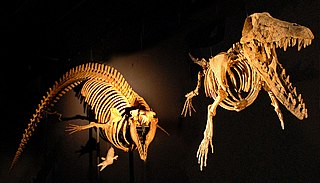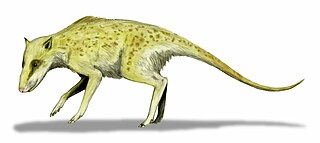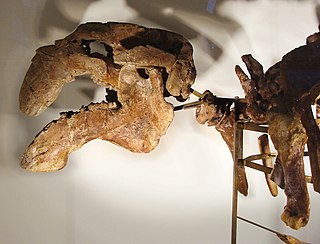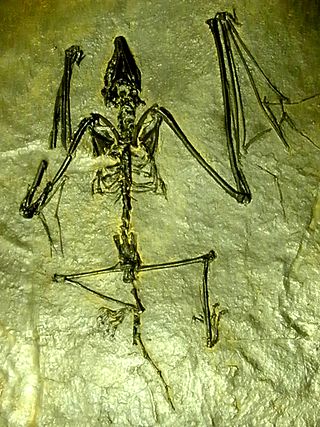
Perissodactyla is an order of ungulates. The order includes about 17 living species divided into three families: Equidae, Rhinocerotidae (rhinoceroses), and Tapiridae (tapirs). They typically have reduced the weight-bearing toes to three or one of the five original toes, though tapirs retain four toes on their front feet. The nonweight-bearing toes are either present, absent, vestigial, or positioned posteriorly. By contrast, artiodactyls bear most of their weight equally on four or two of the five toes: their third and fourth toes. Another difference between the two is that perissodactyls digest plant cellulose in their intestines, rather than in one or more stomach chambers as artiodactyls, with the exception of Suina, do.

Panperissodactyla is a clade of ungulates containing living order Perissodactyla and all extinct ungulates more closely related to Perissodactyla than to Artiodactyla.

Archaeoceti, or Zeuglodontes in older literature, is a paraphyletic group of primitive cetaceans that lived from the Early Eocene to the late Oligocene. Representing the earliest cetacean radiation, they include the initial amphibious stages in cetacean evolution, thus are the ancestors of both modern cetacean suborders, Mysticeti and Odontoceti. This initial diversification occurred in the shallow waters that separated India and Asia 53 to 45 mya, resulting in some 30 species adapted to a fully oceanic life. Echolocation and filter-feeding evolved during a second radiation 36 to 35 mya.
Nakusia is an extinct genus of ungulate from the early Eocene epoch, described in 1999 in the Ghazij formation of Baluchistan, Pakistan. It was classified as an anthracobunid in 1999 but was suggested in a 2014 cladistic analysis to be more likely to belong to Quettacyonidae or Cambaytheriidae.

Kutchicetus is an extinct genus of early whale of the family Remingtonocetidae that lived during Early-Middle Eocene in what is now the coastal border of Pakistan and India. It is closely related to Andrewsiphius with which it was synonymized by Gingerich et al. 2001. Thewissen & Bajpai 2009 proposed a new clade, Andrewsiphiinae, for the two species. Later authors, however, still accept both as separate genera.

The Raoellidae, previously grouped within Helohyidae, are an extinct family of semiaquatic digitigrade artiodactyls in the clade Whippomorpha. Fossils of raoellids are found in Eocene strata of South and Southeast Asia.

Eotheroides is an extinct genus of Eocene sirenian. It is an early member of the family Dugongidae, which includes the extant dugong. Fossils have been found from Egypt, India, and Madagascar. Eotheroides was first described by Richard Owen in 1875 under the name Eotherium, which was replaced by the current name in 1899.

Archaeonycteris is an archaic bat genus whose fossilised remains have been found in Germany, France, England and India.
Indobune is an extinct genus of ungulate endemic to Asia during the Eocene from 55.8—48.6 Ma, living for approximately 7.2 million years.
Indorana is an extinct genus of lissamphibians which existed in what is now India during the Early Eocene. The type and only known species is Indorana prasadi.
Indohyaenodon is an extinct genus of placental mammals from family Indohyaenodontidae within extinct order Hyaenodonta, that lived during the early Eocene in India.

Andrewsiphius is an extinct remingtonocetid early whale known from the Eocene of Gujarat and Kutch, India and Balochistan, Pakistan.
Cambaytherium is an extinct genus of placental mammals in the family Cambaytheriidae whose fossils were found in an open pit coal mine located in Gujarat, India. The mine was a treasure trove full of teeth and bones, over 200 of which were identified as belonging to Cambaytherium thewissi. The fossils were dated to the Early Eocene, 54.5 million years ago, making them slightly younger than the oldest known fossils belonging to the order Perissodactyla.
Marcgodinotius is a genus of adapiform primate that lived in Asia during the early Eocene. It is a monotypic genus, the only species being Marcgodinotius indicus. Another adapiform primate Suratius robustus was found in the same horizon. Anthrasimias may be a junior synonym of Marcgodinotius and Anthrasimias gujaratensis a junior synonym of Marcgodinotius indicus.
Indiagama is an extinct genus of agamid lizard known from the type species Indiagama gujarata from the early Eocene of India. Indiagama was named in 2013 on the basis of a single lower jaw from the Cambay Shale in Gujarat. The rectangular shape of its teeth distinguish it from all other agamids, living and extinct.
Suratagama is an extinct genus of agamid lizard known from the type species Suratagama neeraae from the early Eocene of India. It was named in 2013 on the basis of three isolated jaw bones from the Cambay Shale in Gujarat.
Heterodontagama is an extinct genus of iguanian lizard from the Early Eocene of India. It belongs to the extinct family Priscagamidae, which is otherwise only known from the Late Cretaceous of Mongolia. The type species Heterodontagama borsukae was named in 2013 from several isolated upper and lower jaws found in an exposure of the Cambay Shale in an open-pit coal mine in Gujarat.

The Andrewsiphiinae is an extinct subfamily of early whales of the family Remingtonocetidae. Thiewessen & Bajpai (2009) proposed the clade when Andrewsiphius and Kuchicetus were accepted as separate genera. Kuchicetus was originally synonymized with Andrewsiphius in 2001 by Gingerich et al., but later authors, however, still accept both as separate genera.

Sunil Bajpai is the Chair Professor of Vertebrate Paleontology in the Department of Earth Sciences, Indian Institute of Technology Roorkee. He is in service as a professor at IIT Roorkee since 1st January 1996 till 30 September 2026. He also served as the director of the Birbal Sahni Institute of Palaeosciences from January 2013 to July 2018.
The Cambay Shale Formation is geologic formation in the Cambay Basin, India. It is of lower Eocene age. It varies in thickness from a few meters on the margins of the basin to more than 2,500m in the depressions. It directly overlies the Olpad Formation and is, in turn, overlain by the Anklesvar Formation in the southern part of the basin and by Kalol Formation in the northern part of the basin. Further north, the Cambay Shale, in its lower part, is gradually replaced by tongues of paralic-deltaic Kadi Formation and finally by Tharad Formation.







